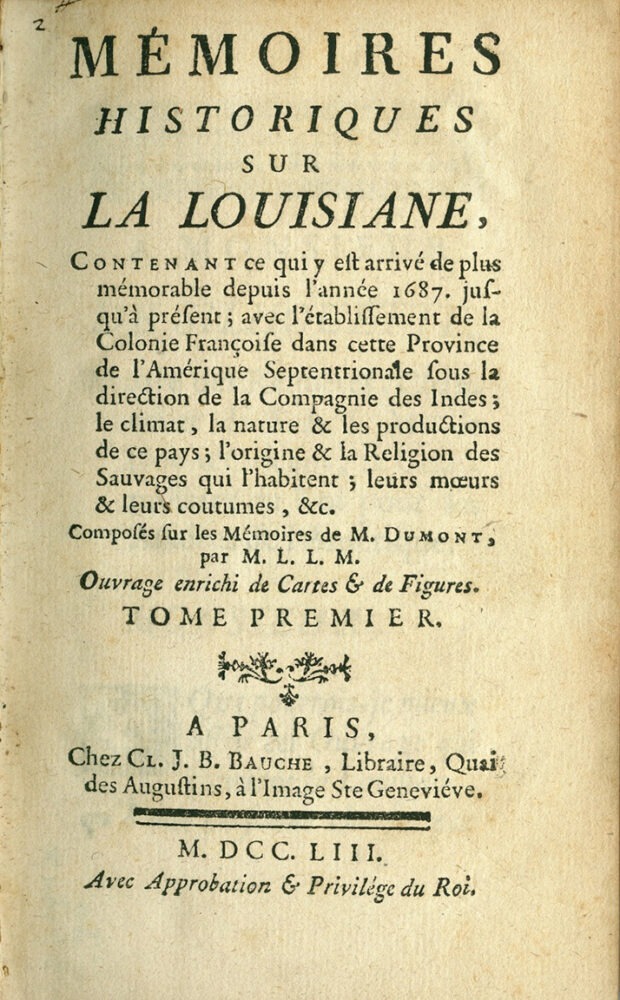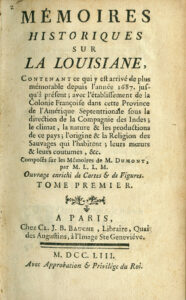Jean-François-Benjamin Dumont de Montigny
Dumont de Montigny is best remembered for writing a colorful, suspenseful, and often humorous memoir about his experience as an officer, farmer, and explorer in eighteenth-century French colonial Louisiana.

The Historic New Orleans Collection
Title page of Jean-Francois-Benjamin Dumont de Montigny's "Memories historiques sur la Louisiane," 1753.
Jean-François-Benjamin Dumont de Montigny was an officer in the French colonial marines in Quebec and Louisiana from 1715 to 1737. He was born in Paris, the second youngest of seven children. His father Jacques-François Dumont was a magistrate in the Parlement of Paris, France’s highest court of appeals. Just after Dumont’s father died in 1718, family connections to Minister of War Claude Le Blanc secured Dumont a commission in the Gardes Marines (French naval officers in training) as an engineer with the rank of lieutenant. He added “de Montigny,” to his surname, as did one of his nieces but none of his brothers, most likely because it sounded more aristocratic.
Military Career
Dumont sailed to Louisiana in 1719, when the financial schemes of John Law, later known as the Mississippi Bubble, inspired speculative investment and a large wave of migration to the colony. The French military assigned troops to build forts and develop farms (or concessions) purchased by investors in Law’s scheme, including Minister Le Blanc and Charles-Louis-Auguste Fouquet, duc de Belle-Isle, another of Dumont’s patrons. Like other colonists Dumont suffered illness and hunger as he traveled from Dauphin Island to Biloxi, to New Orleans, up the Mississippi to Natchez and Yazoo, and later to Pascagoula. Dumont was a poor fit for military life, and he was never promoted in rank, but he participated in exploration of the Arkansas River led by Bénard de la Harpe in the spring of 1722, in the skirmish with the Natchez in autumn 1723, and as a militiaman in the 1736 conflict with the Chickasaw in what is now eastern Mississippi. Dumont was highly critical of Governor Jean-Baptiste Le Moyne, sieur de Bienville, who briefly locked him up in a military brig in the autumn of 1722. Dumont sought revenge by writing to his family and protectors in Paris who may have helped bring about Bienville’s recall to France and replacement by Etienne de Périer, who Dumont admired and described in flattering terms in his poem and memoir.
Writings, Maps, and Drawings
Until recently Dumont was known to historians primarily as the co-author of Mémoires Historiques sur la Louisiane (Historical Memoirs of Louisiana). The book was published in Paris in 1753 under the name of a co-author who had never been to Louisiana, the Abbé Le Mascrier. Dumont’s name did not appear on the title page, but the book was based on writings he had completed over the previous decade: two versions of an epic poem and a lengthy memoir about his experience and the promise and failings of the Louisiana colony. All three manuscripts were written not for publication but as appeals to powerful statesmen and courtiers and as evidence of his loyal service and qualifications for future appointments. The memoir was first published in 2008 and then in English translation in 2012. Dumont wrote in a colorful, suspenseful, and often humorous style about his life as an officer, farmer, and explorer, as well as about key events in Louisiana’s early history such as the founding of New Orleans in 1719–20, the uprising at Natchez and the French response in 1729–30, and the Chickasaw Wars of 1735–9.
The Natchez uprising of 1729 was the key turning point in the history of French Louisiana, as Dumont saw it. Together with the publications of his friend and rival Antoine Simon Le Page du Pratz, Dumont documented the uprising as a tragedy in which both French and Natchez leaders played dramatic roles. In Memoires Historiques Dumont claimed he left Natchez the day before the attack, but his memoir shows that, in truth, he fled Natchez for New Orleans in January due to conflicts with Commandant Chepart, whom he and others blamed for provoking the Natchez. Only recently have historians proposed other causes for what the French saw as a tragic massacre.
Dumont illustrated his poem and memoir with several dozen watercolor illustrations: drawings of animals; portraits of Native Americans, their clothing, hunting practices, and musical instruments; and maps of the colony and its settlements, including his own farms. At least a dozen more of Dumont’s maps are conserved in French archives and verify and illustrate episodes in his memoirs. Dumont’s skills as a draftsman and artist were modest, and most of his maps were drawn from memory to enhance his writings. Although he held the title of engineer, Dumont lacked the surveying and design skills that distinguished his contemporaries Adrien Pauger and Ignace Broutin. The maps nonetheless document the scale and location of early French settlements and nearby Native villages.
Family
The Natchez uprising was a turning point in Dumont’s personal life as well. While posted at Natchez he rented a cabin near the Tioux village from Jean Roussin and his wife Marie Baron, who had been forcibly sent to Louisiana in 1719 after an unjust arrest, accused of theft and prostitution. Dumont was able to write about how the Natchez planned the uprising because Marie had been held hostage for several weeks in the homes of influential Natchez women. The Natchez took the life of her first husband and one of their children, but she and one or two other children were freed and returned to New Orleans in February 1730 in a prisoner swap. Dumont wed Marie Baron in New Orleans on April 19, 1730, and had two children: Marie-Françoise, baptized November 28, 1731, and Jean François, baptized January 2, 1733. After the couple returned to France, they lived in Paris and in Port-Louis, Brittany, until 1754 when Dumont received another commission as a colonial officer with the Company of the Indies. The couple sailed to the Indian Ocean islands of Réunion and Mauritius and then to Pondicherry, India. Dumont died there in 1760 and Marie a few years later.
